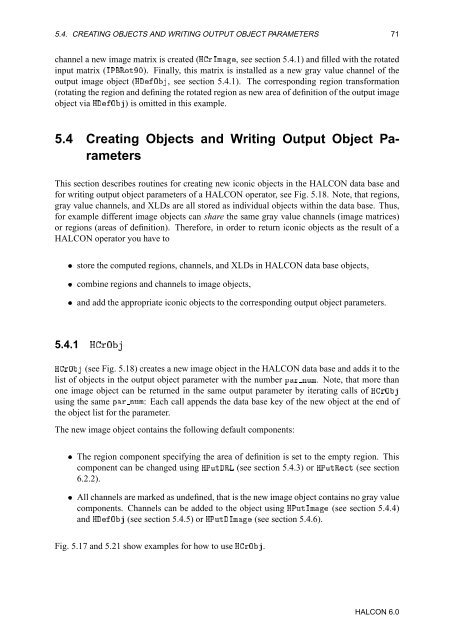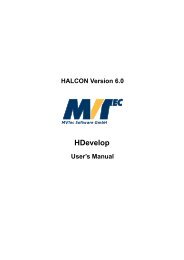HALCON Extension Package Programmer's Manual
HALCON Extension Package Programmer's Manual
HALCON Extension Package Programmer's Manual
- No tags were found...
You also want an ePaper? Increase the reach of your titles
YUMPU automatically turns print PDFs into web optimized ePapers that Google loves.
5.4. CREATING OBJECTS AND WRITING OUTPUT OBJECT PARAMETERS 71channel a new image matrix is created (ÀÖÁÑ, see section 5.4.1) and filled with the rotatedinput matrix (ÁÈÊÓؼ). Finally, this matrix is installed as a new gray value channel of theoutput image object (ÀÇ, see section 5.4.1). The corresponding region transformation(rotating the region and defining the rotated region as new area of definition of the output imageobject via ÀÇ) is omitted in this example.5.4 Creating Objects and Writing Output Object ParametersThis section describes routines for creating new iconic objects in the <strong>HALCON</strong> data base andfor writing output object parameters of a <strong>HALCON</strong> operator, see Fig. 5.18. Note, that regions,gray value channels, and XLDs are all stored as individual objects within the data base. Thus,for example different image objects can share the same gray value channels (image matrices)or regions (areas of definition). Therefore, in order to return iconic objects as the result of a<strong>HALCON</strong> operator you have to¯ store the computed regions, channels, and XLDs in <strong>HALCON</strong> data base objects,¯ combine regions and channels to image objects,¯ and add the appropriate iconic objects to the corresponding output object parameters.5.4.1 ÀÖÇÀÖÇ (see Fig. 5.18) creates a new image object in the <strong>HALCON</strong> data base and adds it to thelist of objects in the output object parameter with the number ÔÖ ÒÙÑ. Note, that more thanone image object can be returned in the same output parameter by iterating calls of ÀÖÇusing the same ÔÖ ÒÙÑ: Each call appends the data base key of the new object at the end ofthe object list for the parameter.The new image object contains the following default components:¯ The region component specifying the area of definition is set to the empty region. Thiscomponent can be changed using ÀÈÙØÊÄ (see section 5.4.3) or ÀÈÙØÊØ (see section6.2.2).¯ All channels are marked as undefined, that is the new image object contains no gray valuecomponents. Channels can be added to the object using ÀÈÙØÁÑ (see section 5.4.4)and ÀÇ (see section 5.4.5) or ÀÈÙØÁÑ (see section 5.4.6).Fig. 5.17 and 5.21 show examples for how to use ÀÖÇ.<strong>HALCON</strong> 6.0
















